INDUSTRIAL &
TERMINAL RAILROADS &
RAIL-MARINE OPERATIONS
OF BROOKLYN, QUEENS, STATEN
ISLAND, BRONX &
MANHATTAN:
POUCH
TERMINAL & RAILROAD
Clifton, Staten Island
.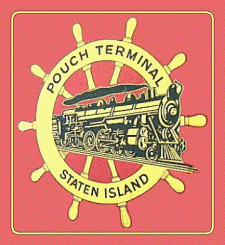
.
updated: |
||
|
|
||
update summary: |
date: | |
| 11/15/1936 photo of Pouch Terminal #1 added | 23 August 2011 | |
.
.


Map of Railroad and Terminal Facilities in the Port of New York
1943 edition.
As both Paul Strubeck and I both are amoured with the Mack switcher of Pouch Terminal, I had listed it's build data here. That in turn led me to research the actual history of the Pouch Terminal.
History
.
As submitted by Ed Bommer; Pouch Terminal was founded in 1916 by William H. Pouch, and occupied Piers 19-21.
Ascertained from research for American Dock Company, there was some ownership / financial connection between American Dock and Pouch Terminal, so both American Dock and Pouch Terminal were somewhat inter-related through members of the Pouch family over the decades.
Pouch Terminal was a pier and warehouse complex on the east shore of Staten Island by Clifton, occupying 3 piers and offering lighterage service, but with no float bridge service.
Pouch Terminal was connected to the Staten Island Railway (operated by the Baltimore & Ohio Railroad), and was connected to the American Dock Co. further north via that railroad.
Paul Strubeck then located some information in the New York New Jersey Port and Harbor Development Commission Joint Report with Comprehensive Plan & Recommendations, 1920:
| The Pouch Terminal is operated
by the Pouch Terminal Company and is located at Clifton, Staten Island.
It has rail service from the Baltimore & Ohio Railroad, three piers and fifteen warehouses, but no floatbridges. It is used by all railroads but it maintains no carfloat or lighterage service.
The following companies are tenants
at it's piers:
|
The image seen at the top of this page, is an excerpt taken from the Map of Railroad and Terminal Facilities in the Port of New York, as issued by the New York Central Railroad in 1943. This image shows the close proximity of Pouch Terminal to American Dock Company. Both terminals are denoted as having lighterage and with a red semi-circle which means Car Load Delivery.
The following image is an advertisement for Turner Construction, and features an image of one the warehouses they constructed for Pouch Terminal. Of particular note is the fact they repeatedly constructed buildings for Pouch Terminal, American Dock, Bush Terminal, New York Dock and Robert Gair (which was located at the Jay Street Terminal).
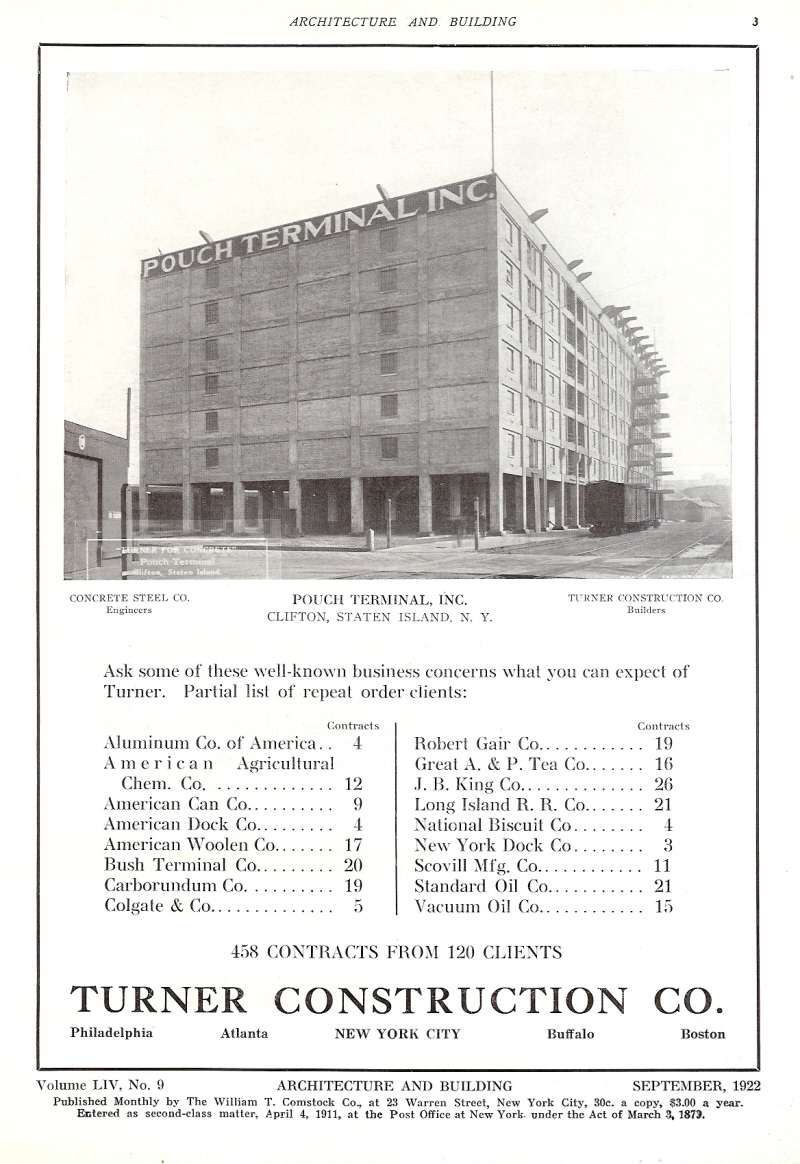
Architecture & Building, vol.... LIV (54) - September
1922
authors
collection
added 26 Dec 2009
.
Inbound freight arriving at Pouch Terminal came directly from ships or lighters at the Pouch Terminal piers, by carfloat via the Baltimore & Ohio Railroad St. George Terminal, or via the Staten Island Railway (Baltimore & Ohio Railroad) via New Jersey and the Arthur Kill vertical lift bridge..
As per "New York Harbor Railroads, Vol... 2" by Thomas Flagg; this terminal went out of business around 1979. The property is now home to a New York Power Authority Gas Turbine Electric Generating Plant.
Locomotives
.
#1
The first known locomotive to operate at Pouch Terminal, was a B wheel arrangement (0-4-0). It was built by Baldwin Locomotive Works in June of 1919. While the Baldwin builders records I have at my disposition fail to note what the fuel was, it was in all likelihood gasoline powered.
The builders records do reflect that this locomotive is listed as a "mule". Understanding of that term denoted an extremely small locomotive.
Imagine my shock on 22 March 2010 when Jon Franz sends me a picture of Pouch Terminal #1:
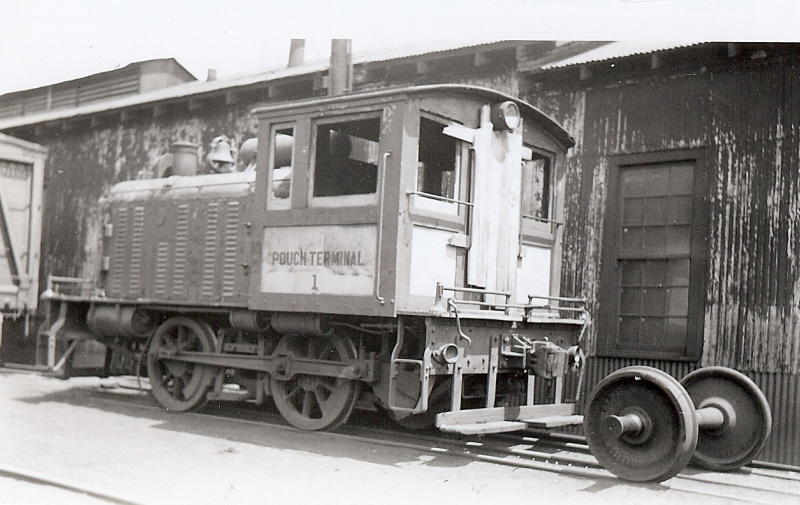
#1 - June 26, 1936 - Clifton, Staten Island, NY
Note back door boarded up and jackshaft drive rods.
H. L. Goldsmith photo
J. Franz collection
added 22 March 2010
.
.
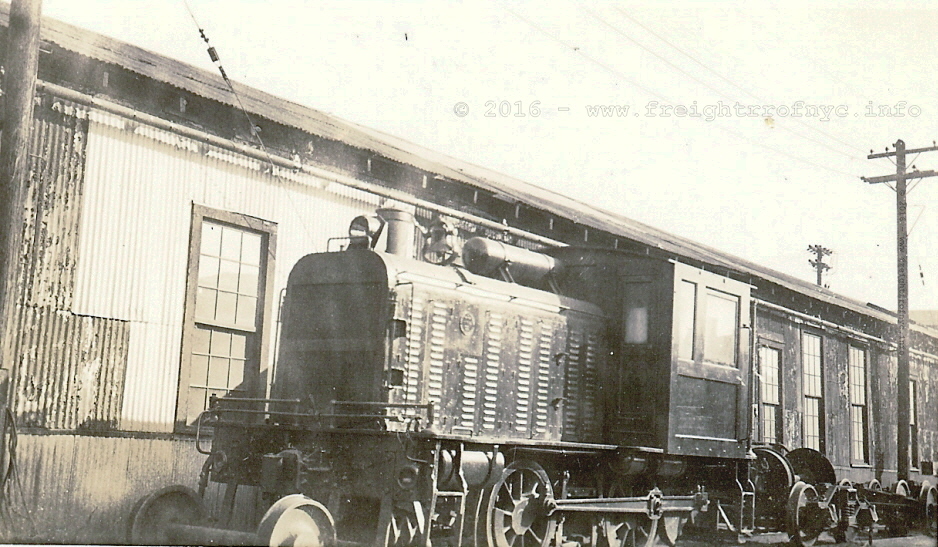
#1 - November 15, 1936 - Clifton, Staten Island,
NY
E. Hermanns photo
authors
collection
added 31 October 2016
..
..
By no means can the locomotive in the picture above be considered "extremely small". Granted it's no Union Pacific Challenger; but honestly I have seen other locomotives in use at other New York Area Terminals that are much smaller: the Atlas Terminal and G & R Packing critters come to mind!
There are several fascinating aspects of this locomotive, the foremost being the jack shaft and siderod drive. This type of drive was commonly seen on early Pennsylvania Railroad electric locomotives such as the DD1, FF1 and L5 models. Also note the floating crank pin on the rear driver. Difficult to see due to the angle, but you can also make out the gravity feed fuel tank on the top of the hood just forward of the cab.
Further reference to Jay Reed's "Critters, Dinkys & Centercabs" notes that this locomotive was powered by a gasoline engine with mechanical drive. The photo of #1 above, matches almost perfectly with the image in that book on the bottom of page 13. Thanks to Jay Reed and his book, we can now positively identify Pouch Terminal #1 as a Baldwin 25 Ton Gas - Mechanical switcher.
The photo above shows #1 with the cab door boarded up and it appears the windows are broken out. The image is dated June 1936, so it is clear the locomotive is out of service, and presumably so since the acquisition of #2 in April 1936 (some references state #2 was built in 1929 - see below).
.
#2
Pouch Terminal #2 is a Type AW 30 ton unit built by Mack (of truck building fame). This locomotive was built with two 6 cylinder Mack gasoline engines developing 135 horsepower each. These engines power a single generator which in turn supplies two traction motors. This locomotive was also originally equipped with dual controls.
There is a discrepancy over when this locomotive was built: Mack builders records show this locomotive was built April 1936. However a Staten Island Advance newspaper article seen below, states this locomotive was built in 1929.
In either case, this locomotive was constructed as a Mack demonstrator unit, with Pouch Terminal purchasing the unit in Seattle, WA and having it shipped back to the East Coast. So perhaps (but unconfirmed), the locomotive was built in 1929 with Pouch Terminal acquiring it in 1936?
I have to add I find this doubtful, as the locomotive immediately preceding Pouch Terminal #2 (and of identical construction and sold to Charles Lennig & Co) has a construction number one less (c/n 172003) than that of Pouch Terminal #2 (c/n 172004).
However, throwing a monkey wrench into this numbering dilemma; is the fact that the Mack six wheeled models (45 Ton "AY") built for the Lehigh Valley Railroad, bore higher construction numbers 173001 and 173002, yet were built in December 1929!
Regardless of when it was built, #2 would faithfully serve Pouch Terminal for many decades. In 1958, #2 was overhauled at the Clifton Shops of the Staten Island Rapid Transit. By chance, the freight lead for Pouch Terminal ran through the Clifton Shop area, next to the retaining wall for the mainline and Clifton Station.
Ed Bommer related that in 1959, he had a chance to photograph, measure and ride on this locomotive at Pouch Terminal. When running, Pouch Terminal most often used only one of the engine and traction motor sets. With both sets running however, it could pull about 15 cars on the level, more than enough for the confines of the Pouch Terminal area.
For most of its life it wore black paint, but sometime around 1970 or 1971, it was given a spiffy looking red paint job, with imitation gold pin striping. A Pouch Terminal emblem, consisting of a ships wheel and steam locomotive was added to the cab sides. Under this emblem, it would wear the moniker "Yard Engine 2".
Here is the 1971 Staten Island Advance newspaper article on the locomotive:
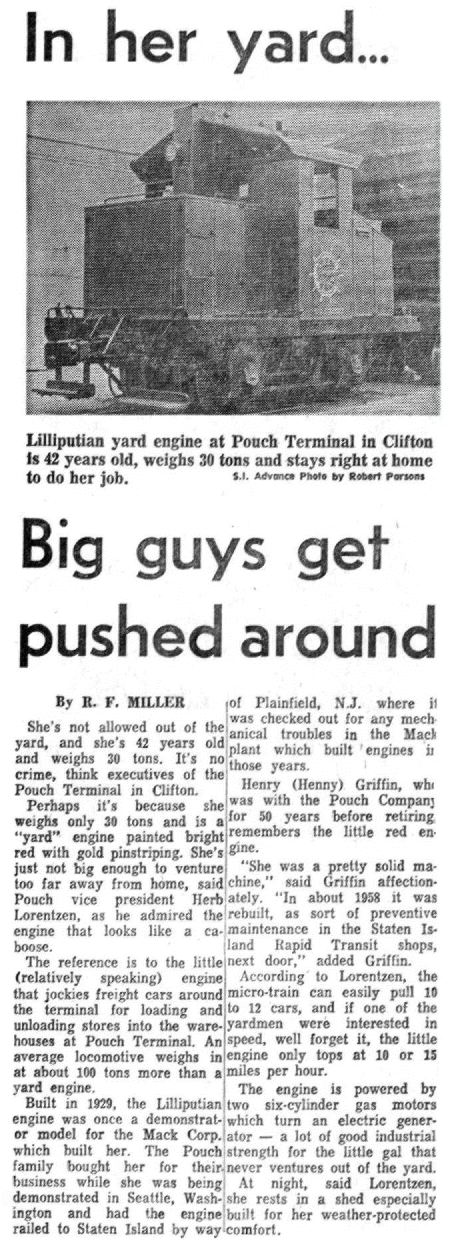
Staten Island Advance - 1971
courtesy of Ed
Bommer
added 26 Jan 2009
.
.
It is believed that #2 operated right up until the closure of Pouch Terminal circa 1979. .
.
|
| .
. |
|
| .
. |
|
| .
. |
|
| .
. |
|
| .
. |
|
| .
. |
|
| .
. |
|
.
.
On 23 August 2011, I came across the following video on YouTube. It is film footage of Pouch Terminal #2 being taken out of it's enginehouse, loaded on a lowboy trailer for transport to, and arrival at Allaire State Park. This video is courtesy of Jack at allvintagetrucks.com:
.
#2 - Present Day
I have located the Pouch Terminal locomotive after a chance encounter with fellow railroad historian Ron Wallace. #2 is currently at the Pine Creek RR, in NJ. As this is a narrow gauge outfit, I don't believe the Mack sees any use as it is standard gauge.
Also the pictures of the Mack on the Pine Creek website show the locomotive to be stored indoors with various tools, lumber and material stored on the running boards and against the locomotive.
On 10 January 2010, I was sent a link to the webpage of J. C. McHugh, which concerned the history of Mack Locomotives #4 & 5. In this website, it was learned that Pouch Terminal #2 was damaged in transit from Staten Island to Pine Creek, NJ
I contacted and received an email from J. C. McHugh containing the following:
"Thank you for writing. We had moved several coaches to Pine Creek over the years back then. We had quoted them a price to haul the Pouch Terminal #2 that could be ramped without cranes and transported on a very lowbed trailer. This would resulted in the locomotive not being damaged because it would not had been as high in overall height as when done by the other firm who hauled it.
Our quoted price was $500.00 more than that the other firm. But they got what they paid for, as (the locomotive) it was delivered damaged and the carrier did not have insurance to cover the repairs."
So with this most recent revelation, it is now unknown as to what extent the locomotive is damaged.
Eight days later, I receive an email from Joe Connelly, who wrote the following:
"I recently saw your website concerning Pouch Terminal Rwy #2 and wanted to clear up how the locomotive got to where it is. My name is Joe Connelly and I worked at Pouch Terminal in the 1980s. Mr. Pouch had turned to warehouse into office space and the pier into parking lot for NYC Transit and there was no longer a need for the locomotive. The picture of the locomotive outside of the sheet metal building which you labeled "#2 unknown time and location" actually looks like a photo I took. The metal building was where the locomotive was stored on the terminal. When you entered the gate at Pouch Terminal from the street, the building was to the left. That building was the start of why the locomotive was moved.
Mr. Pouch wanted to raze the building, which would have left the locomotive exposed so he intended to scrap the locomotive. I interceded and told him of the historical significance of the locomotive and asked him to consider donating it for display and use. He offered the locomotive to me and I initially was going to offer the locomotive to the Jersey Central Chapter of the NRHS the officers of the chapter were fighting and threatening to sue each other, so I offered it to the NJ Museum of Transportation at Allaire State Park. The locomotive is a Mack, which had historical ties to NJ, so it belonged in the state.
Mr. Pouch was also in such a hurry to move the locomotive off the property so we had very little time... I think it was 30 days to move it before it was going to scrap. When the locomotive was moved from Staten Island to Allaire State Park the stack struck an overpass at low speed and the damage was merely superficial sheet metal damage. The locomotive was capable of running when it was moved and was displayed at Allaire on the dual gauge track outside of their engine house for awhile. For my effort I received a gold membership card, which has not survived my moves for my employer, Federal Railroad Administration.
It is a shame that the locomotive has met the same fate as when Mr. Pouch had it stored. I know that he had hoped it would be used and occupy the historical prominence that it deserves. BTW, if you look carefully at any of the in service photos you will note the stack rises above the roof. If you look at the photo inside the engine house at Allaire you notice the stack is shorter and that is what was damaged...it's all superficial."
.
As I stated to Mr. Connelly in my reply; one of the benefits of this historical compilation being of electronic format (as opposed to a printed and bound book); is the website is dynamic and I can correct or amend incorrect info or add info as it arrives.
So, we now have the next piece of the puzzle in the move of #2. Fortunately, as Mr. Connelly states; the damage is minimal and restricted to an exhaust stack and sheet metal..
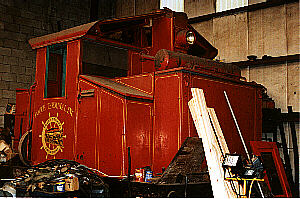
#2 - unknown date
in storage at Pine Creek RR
unknown photographer.
.
Pouch Terminal Locomotive Roster
| number / name |
builder |
c/n |
build date |
gauge |
wheel arrangement |
wheel dia |
acquired |
disposition |
notes |
ref |
| #1 | Baldwin | 51843 | 6/1919 | std. | B - mule | 42" | new | retired 1936 | 125 hp 25 Ton Gas-Mechanical |
[2] [18] |
| #2 | Mack | 172004 | 4/1936 [a] |
std. | B | new | to New Jersey Mueum of Transportation / Pine Creek RR;Allaire State Park, NJ in storage |
Gas / Electric Type AW 30T (2) 6 cyl 270 hp total |
[10] [a] |
Locomotive Footnotes
[a] |
There are some interesting discrepancies
in this article to the Mack builders information that I have received. According
to the SI Advance article seen above, this locomotive was built in 1929,
yet Mack builders records state this locomotive was built in April
1936.
.
. |
Memorabilia

Silicon Bronze Letter Opener - side 1: Pouch Terminal
.
.

Silicon Bronze Letter Opener - side 2: American Dock Co
authors collection
.
.
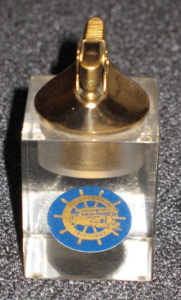
Lighter (fluid type - lighter component mfr'd by
United).
unknown mf'r of entire unit
authors collection
.
.
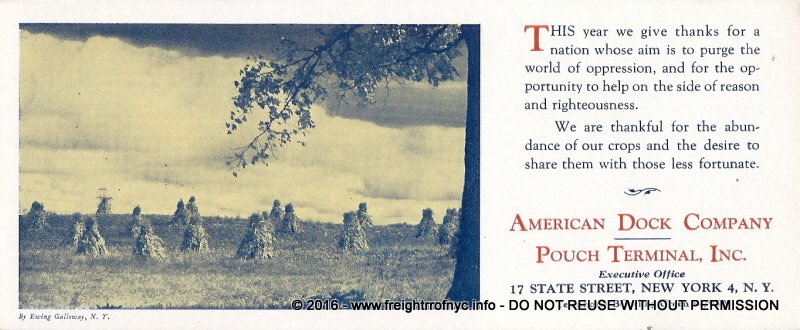
Advertising Card / Blotter - unknown date (circa World War 2?)
authors
collection
added 08 August 2011
.
.
.
Like what you see? Suggestions? Comments?